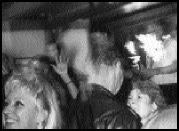NOISE! SHADOWS! Concrete! Oh, my!
By the time you read this, the proposed route for the monorail through Belltown will likely have been narrowed to an awkward, expensive route down Fifth Avenue, thanks largely to howls of protest from Belltown property owners.
This week, the board of the Elevated Transportation Company (ETC)—the agency charged with bringing a monorail plan to voters—is expected to pick its preliminary preferred route through Belltown, a major step in deciding the final route of the proposed 14-mile monorail from Ballard to West Seattle. The preferred option, a winding, circuitous route that would go around Seattle Center and down Fifth, would knock out the current monorail, leave a gaping hole in the heart of the Experience Music Project, and take several minutes longer than the alternative route, a straight shot up Second Avenue.
Why would the ETC choose a route that, according to its own proponents, will cost taxpayers more and take longer? For one thing, Fifth Avenue already has a monorail, making it harder to argue that property values there would be diminished by a new transit system. Moreover, says ETC staff member Joel Horn, the current monorail is comparatively ugly, loud, and obtrusive; a replacement monorail, with narrower, more widely spaced columns and a higher platform, “would actually have a positive impact” on Fifth.
But perhaps the most important reason the ETC decided to run the monorail up Fifth was the outrage that ensued when it even suggested running it up Second. And for that, you can thank a small but motivated group of Belltown condo residents and property owners, who argued forcefully from day one that having that thing on their street would decimate property values, disrupt the flow of traffic, and ruin the ambience of Second.
What appears to have been lost in all the cacophony over this comparatively small stretch of the route is that Belltown residents do, after all, live downtown, where buses rumble by constantly, where pretty much everything is made out of concrete, and where big condo buildings are far worse impediments to downtown denizens’ views than a 30-foot-high monorail. “If the choice I was given was a major bus route vs. a monorail, I think the monorail would be much more pleasant to listen to,” says monorail initiative author Peter Sherwin.
Even those who didn’t oppose the Fifth Avenue route acknowledge that from a “save the neighborhood” perspective, some of the Second Avenue residents’ arguments sounded pretty silly. “Very likely, if the Space Needle was being built today, they would say, ‘I don’t want that awful concrete structure in the air. It would block my view of Queen Anne,'” says ETC board member Dick Falkenbury. “Their condos block the views of the people behind them. It’s the pot calling the kettle black.”
Meanwhile, the arguments for Second are numerous and compelling. For one thing, a Second Avenue monorail would run through the heart of Belltown, serving bus commuters better than the more remote eastern alternative. A monorail on Second could also link up more easily with Metro’s downtown bus tunnel, because it would be almost level with the tunnel’s Third Avenue entrance. (The option of turning the monorail at Stewart and running it down Second was also on the table.) The Second Avenue option would cost less, be more direct, and involve fewer tricky twists and turns, according to the ETC’s Horn, who says the Fifth Avenue route would take between two and four minutes longer from end to end.
And then there’s the question of what to do with that other monorail, the one that’s spent the last 40 years shuttling tourists and locals between downtown and Seattle Center. If the new monorail goes up Fifth, the old one will be demolished (and not, as some have optimistically predicted, extended), leaving an ugly hole in the middle of EMP. Tom Albro, president of Railsafe, which runs the existing monorail, says he doesn’t want “to wander into the debate at this point,” but wants to be treated fairly. ETC board member Tom Weeks acknowledges that “there need to be some details worked out” with RailSafe before the monorail can move forward with the Fifth Avenue alternative. “That’s a profitable enterprise right now, and we’d be asking them to close it down.”
Ironically, even proponents of the Fifth Avenue route note that Fifth has grown and thrived around the monorail, a fact that would seem to suggest monorails—like other transit systems—are a good thing, both for property values and general neighborhood ambience. Given time, Falkenbury believes, even Second Avenue “would come to love and embrace it.”







